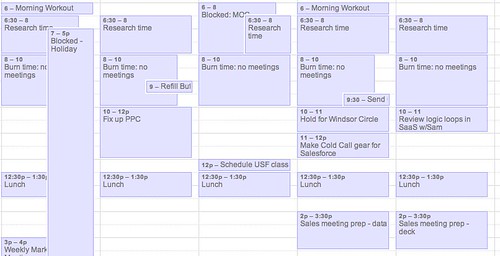Justin Levy asked on Facebook:
Also, as a follow up to your daily reading workflow post, I’m always interested in seeing how people organize their days and knowing you, it’s organized for optimal productivity.
Great question.
First and foremost, I make religious use of my calendar. I use Google Calendar as my central taskmaster hub, and stuff it full of items. It syncs down to my Mac, to iCal, to the iPad, to my devices, to iCloud, etc. and it is the “authoritative” schedule of my day. Take a look at a sample week:
Note a few important things. I use the Tungle.me service to invite others to schedule meetings with me. As a result, it’s important that I’m very clear what times are and are not available. Each day, I have lunch scheduled. I need that break in the middle of the day in order to achieve maximum productivity, and so I block it off. Yes, in my head it’s flexible as circumstances dictate, but no one is allowed to schedule that time except me. Likewise, you see blocks for morning workouts on there for the same reason.
Here’s the cardinal rule of calendaring and scheduling: if you don’t schedule yourself, someone else will. Set times aside for important stuff, personal and professional.
There’s a second oddity of note on there: from 6:30 AM to 10 AM each day, there are two blocks. One block is labeled research time, the other is labeled burn time. Neither of those blocks can be scheduled. What happens during those times? During research time, I hit my reading list for the day. Before I sit down to create, I fill my head with news and items so that the information has time to percolate and slosh around.
The second block, burn time, is content creation. It’s when I pump out blog posts, respond to emails, write eBooks, and make things. You see the results of that every day on the WhatCounts blog, on my blog, on Twitter, etc.
Why do those two blocks exist? Simple: I know that the first 3-4 hours of the workday are the most productive for me. The coffee is strong and the phones/inboxes are quiet. It’s the period of the day when I can burn things down (hence its name on the calendar, burn time) with little interruption.
What happens in all of the unscheduled spaces? Life. There are always projects that need work, from adjusting PPC ads to working on the latest eBook, things that will gladly absorb any amount of time that you throw at them. That’s what goes on in between the meetings and other voids in the schedule.
The best way I can summarize my schedule is with the parable of big rocks from Stephen Covey (click here to read it). I use Google Calendar to place all the big rocks, and then let the rest of the workday happen in the spaces that are left.

Leave a Reply